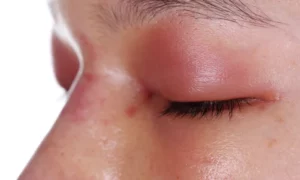Imagine waking up after squint surgery, a mix of relief and anticipation coursing through you. You’ve taken the brave step towards clearer, more aligned vision. But, you may wonder, what comes next? What does the road to recovery look like? In the next few minutes, you’ll learn about the typical recovery time after undergoing squint surgery, how to handle common symptoms, and the steps to take for post-operative care to make your recovery as smooth as possible. Whether it’s managing swelling or understanding potential complications, we’ve got you covered. So, let’s dive in!
Contents
Understanding the Timeline
After squint surgery, it’s natural to be curious about what lies ahead. Let’s break down the recovery timeline, so you know what to expect.
Immediate Post-Op: The moment you open your eyes after squint surgery, you might notice things are a bit blurry. That’s perfectly normal. Your eyes need time to adjust. You may also feel some discomfort, but don’t worry; this is temporary.
The First Week: In the first week, your vision will gradually improve. The initial blurriness will start to fade, and you’ll begin to see the world more clearly. During this time, you’ll need to be extra careful with your eyes. Your doctor will likely recommend eye drops and ointments to keep your eyes moist and help with healing. It’s crucial to follow their instructions diligently.
Beyond the First Week: As you move beyond the first week, you’ll notice more improvements in your vision. The discomfort will continue to decrease, and you’ll start feeling like yourself again. Your doctor may schedule follow-up appointments to monitor your progress. This is also the time when you can start getting back to your regular activities, but it’s essential to ease back in gradually and not rush your recovery.
Understanding this recovery timeline will help you prepare for what’s to come. Remember, every individual’s healing pace is unique, so don’t be discouraged if your experience varies slightly. With patience, proper care, and the guidance of your medical team, you’ll be on your way to clearer, more aligned vision.
Common Recovery Symptoms
 Recovery after squint surgery can come with a few bumps in the road, but being informed about the common symptoms can help you handle them with confidence.
Recovery after squint surgery can come with a few bumps in the road, but being informed about the common symptoms can help you handle them with confidence.
1. Blurriness and Discomfort:
- What to Expect: Immediately after the surgery, your vision may be blurry, and you might feel some discomfort or mild pain.
- How to Manage: Rest and follow your doctor’s prescribed eye drops or medications. It’s crucial to avoid rubbing your eyes, which can worsen the discomfort.
2. Redness and Swelling:
- What to Expect: It’s common to experience redness and swelling around the surgical area.
- How to Manage: Applying a cold compress can help reduce swelling. Your doctor may also recommend over-the-counter pain relievers to ease any discomfort.
3. Light Sensitivity:
- What to Expect: You might find that your eyes are more sensitive to light, making it uncomfortable to be in bright or direct sunlight.
- How to Manage: Wear sunglasses to protect your eyes and stay in well-lit but not overly bright environments.
4. Tearing and Dryness:
- What to Expect: Your eyes might tear up more than usual, but you may also experience dryness.
- How to Manage: Use artificial tears as recommended by your doctor to maintain the moisture balance in your eyes.
5. Itchiness or Foreign Body Sensation:
- What to Expect: You may experience a mild itching sensation or feel like there’s something in your eye.
- How to Manage: Avoid touching or rubbing your eyes, and consult your doctor if the sensation persists.
Understanding these common symptoms can ease your worries. Remember, they are usually temporary and a part of the healing process. If any symptoms worsen or become severe, don’t hesitate to contact your doctor. Their guidance is invaluable in ensuring a smooth and successful recovery.
Post-Operative Care Instructions

You’ve taken the bold step of squint surgery, and now it’s time to ensure a smooth and successful recovery. Let’s delve into the essential post-operative care instructions:
1. Proper Eye Care:
- Keep It Clean: Gently clean the area around your eyes with a mild, non-irritating cleanser. Avoid getting any soap or water directly into your eyes.
- No Rubbing: Avoid rubbing your eyes at all costs. It can interfere with the healing process.
2. Medications and Eye Drops:
- Follow the Prescriptions: Take any prescribed medications and eye drops exactly as instructed by your doctor. These are vital for reducing inflammation and preventing infection.
3. Protect Your Eyes:
- Sunglasses: Wear sunglasses when you’re outside, as your eyes may be more sensitive to light during the early stages of recovery.
- Avoid Dust and Allergens: Keep your surroundings as dust-free as possible, and avoid allergens that could irritate your eyes.
4. Rest and Recovery:
- Take It Easy: Give your body the rest it needs. Avoid strenuous activities, especially during the first week after surgery.
- Sleep Upright: Sleeping with your head elevated can help reduce swelling.
5. Diet and Hydration:
- Stay Hydrated: Drink plenty of water to help your body heal.
- Nutritious Diet: Consume a balanced diet rich in vitamins and minerals to support your recovery.
6. Follow-Up Appointments:
- Stick to the Schedule: Attend all follow-up appointments with your doctor. These visits are essential to monitor your progress and make any necessary adjustments to your treatment plan.
7. Be Patient:
- Healing Takes Time: Understand that healing is a process, and it may take some time for your vision to fully stabilize.
By following these post-operative care instructions diligently, you’re giving yourself the best chance for a smooth recovery and you’ll soon enjoy the benefits of squint surgery with improved vision and eye alignment.
What To Expect During the First 24 Hours
In the first 24 hours following squint surgery, you may experience various sensations. Here’s what you can expect in easy-to-understand bullet points:
- Blurred Vision: Your vision will likely be blurry right after the surgery. This is normal and will gradually improve over the next few days.
- Mild Pain or Discomfort: You may feel some mild pain or discomfort around the surgical area. Your doctor will provide pain relief to manage this.
- Redness and Swelling: It’s common to have redness and swelling around your eyes, but this should also improve as you heal.
- Sensitivity to Light: You might find bright lights uncomfortable. Wearing sunglasses when you’re outside can help.
- Tearing and Dryness: Your eyes may tear up more than usual, but you may also experience dryness. Using prescribed eye drops will help maintain moisture balance.
- No Rubbing: Avoid rubbing your eyes at all costs, as this can hinder the healing process.
Remember, these sensations are typically temporary and part of the healing process. If you experience severe pain or any concerning symptoms, don’t hesitate to contact your doctor. They are there to support you through your recovery journey.
Managing Swelling and Bruising
Swelling and bruising are common side effects after squint surgery. Here’s how to handle them effectively:
- Cold Compress: Applying a cold compress (a clean cloth soaked in cold water) gently to the swollen area for 10-15 minutes at a time can help reduce swelling.
- Elevate Your Head: Sleeping with your head elevated by using an extra pillow can minimize swelling around the eyes.
- Prescribed Medications: Take any prescribed medications, including pain relievers and anti-inflammatories, as directed by your doctor.
- Arnica Cream or Gel: Some individuals find that applying arnica cream or gel to bruised areas can help reduce bruising and speed up the healing process.
- Avoid Blood Thinners: Refrain from taking blood-thinning medications, such as aspirin, as they can exacerbate bruising.
- Time: Remember that both swelling and bruising will subside as your body heals. This is a normal part of the post-operative process.
By following these strategies, you can effectively manage swelling and bruising after squint surgery and promote a more comfortable and quicker recovery.
Potential Complications and When to Seek Help
 While squint surgery is generally safe, it’s essential to be aware of potential complications and when to reach out to your healthcare provider. Here’s what you should know:
While squint surgery is generally safe, it’s essential to be aware of potential complications and when to reach out to your healthcare provider. Here’s what you should know:
1. Infection: Keep an eye out for signs of infection, such as increasing redness, warmth, swelling, discharge, or worsening pain in the surgical area.
2. Severe Pain: If you experience severe, unrelenting pain that doesn’t improve with prescribed pain relief, it’s a sign that something may be amiss.
3. Sudden Changes in Vision: Significant changes in your vision, such as sudden blurriness or double vision, may indicate a problem.
4. Persistent Swelling or Bruising: While some swelling and bruising are expected, if these symptoms worsen or persist beyond the usual recovery period, contact your doctor.
5. Abnormal Discharge: Any unusual discharge from your eye, such as pus or excessive tearing, could signal an issue. Inform your healthcare provider if this happens.
6. Allergic Reactions: If you notice signs of an allergic reaction to any prescribed medications, such as itching, hives, or difficulty breathing, seek immediate medical assistance.
7. Uneven Alignment: If you notice that your eyes are not aligning correctly or if the alignment changes significantly after the surgery, contact your eye specialist.
Remember, prompt communication with your healthcare provider is crucial if you experience any of these warning signs or have concerns about your recovery. They are there to support you and address any complications that may arise during your healing journey.
Conclusion
As we conclude this journey through the recovery process after squint surgery, we hope you now feel more informed, prepared, and confident about what lies ahead. Your decision to undergo squint surgery is a courageous step toward improved vision and self-esteem, and the road to recovery, though it may have its challenges, is a path to a brighter future.
Remember to follow the post-operative care instructions diligently, be patient with the healing process, and don’t hesitate to reach out to your healthcare provider if you encounter any concerning symptoms or complications.
If you or someone you know is dealing with a squint eye condition and considering squint surgery, don’t hesitate to reach out to a qualified eye specialist. Your journey towards clearer vision and greater confidence begins with a simple consultation. Take the first step and schedule an appointment now at 9711116605.



